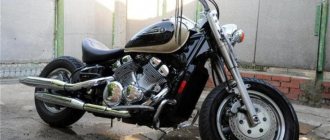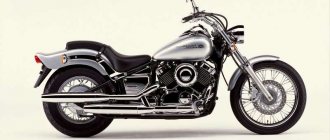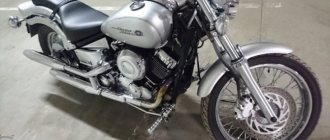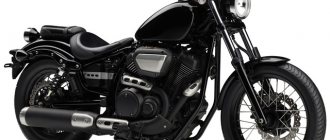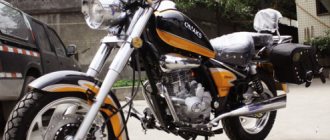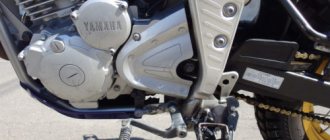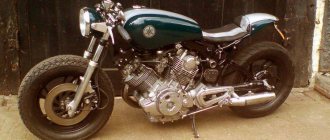Yamaha Vmax Cruiser
The Yamaha VMAX engine with a capacity of 1679 cubic centimeters has more than serious power and torque, thanks to which the VMAX is considered one of the most “riding” motorcycles, and two large six-piston front calipers are able to keep it in check. The 2021 VMAX cruiser is designed to impress even the most cold-blooded.
Let's see what the “tuning fork” company plans to please us with for the next model year.
History of Yamaha VMAX
The history of the Yamaha VMAX goes back 33 years, during which it was produced either directly by Yamaha or by its American cruiser division Star Motorcycles. When one of them passes somewhere nearby, the first thing that comes to mind is Mad Max - that's the impression the design of these monsters makes. Functional air intakes on both sides of the tank form shoulders that create a sneaking bulldog-hidden gazelle silhouette. It’s difficult to seriously consider it as a cruiser, but that’s how the manufacturer positions it, confirming this with a relatively relaxed upright seating position.
Midnight Star 1300 and Stryker
The first variation was a typical cruiser, but Stryker was classified as a chopper. Yamaha has outdone itself in terms of engines for these motorcycles by implementing liquid cooling in the internal combustion engine. There was practically no traction at the bottom, it was important to choose the right gear and this alone made it possible to develop speed in a minimum time.
These motorcycles had an unusual filling for their generation and the temperament that the manufacturer adhered to. However, it was this duo that replaced the previous Drag Star line. Although, to be frank, the hardware of the equipment remained the same, but the appearance acquired a number of changes.
Yamaha Stryker 2011
Vmax 2021
The shape of the tank allows you to lean towards the steering wheel without any obstacles, so that when accelerating you can take a “sporty” position, resisting the wind and overload, and the deep seat with support prevents you from sliding onto the passenger side. The Yamaha VMAX cruiser is a black sheep with an identity crisis, because having an undoubted relationship with cruisers, it has all the signs of the dominant genes of a sportbike, and flaunts this side of its pedigree with might and main.
Yamaha VMAX 2019 Cruiser
Yamaha chopper XVS 1300 Midnight Star
Proudly sitting on the throne of all existing Yamaha choppers is the Yamaha XVS 1300 Midnight Star along with the XV 1900 Raider and XV 1900. They were supplied to both the European and American markets, had V-shaped air-cooled gasoline engines, and the displacement was increased up to two liters of fuel. These motorcycles represented the pinnacle of Japanese technology, with one being a chopper and the other a cruiser.
Yamaha XVS 1300 Midnight Star
You can talk endlessly about Yamaha’s creations, but it is this technique that meets all the requirements of modern bikers. There are no problems, there are no complex designs, and even vice versa - the manufacturer has followed the simplest, most reliable and even stylish path.
The terribly powerful engine saves fuel, provides excellent dynamics and handling, but we can assure people with confidence that Japanese-made motorcycles will probably soon dictate their terms.
Post Views: 18,375
Yamaha Vmax 2021 chassis
The all-aluminum chassis , which forms the frame of the motorcycle with a cast diagonal frame and swingarm, and a prominent subframe make the motorcycle relatively lightweight. The tank is located under the seat, giving the bike a lower center of gravity and better handling at low speeds, but having to wave a dripping fuel nozzle over the seat every time you fill up makes this a dubious decision.
The massive inverted fork creates a very solid front end. The diameter of the stays is 52 mm, and the front suspension travel is 119 mm. The fork is equipped with a typical set of settings - spring preload and rebound/compression damping. The headset angle is 31 degrees, and the trail is 147 mm. The oscillations of the rear pendulum are smoothed out by a fully adjustable monoshock absorber, including the presence of a remote air tank.
The Yamaha Vmax braking system will stop even a bear, thanks to a pair of 320 discs up front and a single 298 disc at the rear. The two Brembo calipers at the front have six opposed pistons each, while the rear caliper is a single-piston caliper, also from Brembo. Of course, the coordinated work of the twelve pistons of the front brake creates a huge stopping force, so it is very nice that the motorcycle is equipped with ABS - it needs it like few others.
Engine Vmax
The heart of the Yamaha Vmax motorcycle is a four-cylinder V-shaped liquid-cooled engine with a total volume of 1679 cc. cm. This massive piece of moving hot metal occupies the entire considerable width of the motorcycle, but it is anything but “extra weight”. According to official information, it produces 166.8 Nm at 6500 rpm, and this is 13.6 Nm more than the first representative of this engine family from 2009. There is no official information on horsepower yet, but it is unlikely to be weaker than the 175 hp ancestor
A number of independent systems cooperate to manage this power. Yamaha's proprietary electronic throttle and YCC-T electronic throttle instead of a mechanical cable make throttle response smoother and more harmonious, with a flatter power distribution curve. An electronically controlled intake, similar to that of the MV Agusta, reduces the length of the intake tract at high revs, allowing full power to be delivered a little earlier and more sharply.
The slipper clutch adds safety during aggressive downshifts and makes the Vmax clutch handle easier to operate. A five-speed transmission sends power to the rear wheel via a driveshaft that can handle serious engine power.
Yamaha is a representative of the “big Japanese four” in the world of motorcycles.
The Yamaha line of choppers is quite extensive, and motorcycles from this company are very popular all over the world. The company began producing choppers in the 80s, wanting to win part of the market from Harley-Davidson. And, betting on the American style of motorcycle construction, the Japanese were right... It all started with the
Yamaha Virago . The first motorcycles in this series, Virago 920j, were of the “classic” type. Then, with the release of 400 cc and 750 cc models, there was a shift in style towards choppers. However, Virago remained a kind of hybrid - a motorcycle on the verge of two styles, incorporating features of both classics and choppers. A classic stance, a distinctive backbone frame and a short wheelbase were combined with an air-cooled V-twin with excellent low-end traction and an overall “chopper” appearance. This model hit the bull's eye - over more than ten years of production, these motorcycles have gained not only great popularity, but also provided Yamaha choppers with a springboard for attacking the minds, hearts and wallets of bikers. Even now, many years after production ceased, “Virags” are often found on the secondary market, and will continue to be found for a long time. Yamaha made a chopper, as they say, for centuries.
Yamaha Drag Star
series came to replace the Viragas . This Yamaha project turned out to be phenomenally successful - choppers made in the classic American style became incredibly popular, and remain at the heights of fame to this day, despite the fact that these motorcycles were discontinued in 2008-2009. Balanced, not too expensive, reliable and beautiful, “Drag Stars” are loved by many, many chopper lovers. Produced in a wide variety of cubic capacity, from 125 to 1100 cubic centimeters of volume, these motorcycles are still on sale in huge quantities to this day. The “liter” version generally became a trump card for Yamaha. Even in the USA, the homeland of Harley-Davidson, these choppers gained an army of fans, being produced there under the sub-brand Star Motorcycles and the name V-Star. This project gave Yamaha a strong position in the chopper and cruiser market. Cheaper than the “Americans”, but with sufficient power, reliable, stylish, the Yamaha V-Star (American name) has become the choice of many. They continued what Viragami had started, gaining a foothold in the market and providing Yamaha with the reputation of producing excellent choppers.
In parallel with the Drag Stars, their older brothers were also produced - Yamaha XV 1600 Road Star, in the USA - Wild Star. No longer choppers, but cruisers, these motorcycles looked like a slightly enlarged Drag Star, equipped with a more than one and a half liter air engine, generous with vibrations. And these bikes vibrate noticeably, since the model was developed by Yamaha for the American market, and Americans love vibrations, so the designers removed one of the two balance shafts from the XV 1600 engine, providing happy owners with the strongest vibrations at idle.
In the mid-2000s, Yamaha decided to restyling, releasing the XV 1700 model, which differed from its predecessors in a slightly modified engine and power system - a carburetor instead of an injector, with the exception of the first versions.
One cannot fail to mention the Yamaha Royal Star . Powered by a liquid-cooled V-4 engine, this motorcycle dates back to the early 1980s and is still alive and well today. The modern incarnation of this cruiser has three versions, including the Venture version - a luxury cruiser for long trips with maximum comfort. Otherwise, this big and heavy chopper is, without a doubt, also very good, although it is atypical for Yamaha with its V-4 and liquid cooling system. True, in our time, not everyone likes its rather archaic design.
The Yamaha XV 1700 Warrior
stands apart . A vicious city hooligan, this chopper stands out from its other peers in the lineup. Compact and sharp, it gives the impression of a motorcycle created by Yamaha specifically for lovers of an aggressive riding style. 80 horsepower, hellish torque, a smart injection system and a belt drive, coupled with excellent handling, made it popular among those who like to roar through city streets. However, the appearance of this chopper is already a clear departure from the classical canons. However, Yamaha decided to take a risk, giving its brainchild such a defiant, almost kitschy appearance, and it was right.
Let's return to the Yamaha Drag Star series. These motorcycles were discontinued in the late 2000s and were replaced by the Midnight Star series, which includes motorcycles with engines of 950, 1300 and 1900 cubic centimeters.
All are fuel-injected, all are belt-driven, all are V-twin.
The 950 cc and 1900 cc engines are air cooled, the 1300 cc engine is liquid cooled. The most affordable Yamahas of this generation are the XVS 950 Midnight Star and XV 950 Bolt . They only have the same engine, everything else is radically different. And if the first is a pure cruiser, then the second is an attempt to produce a serial chopper or bobber.
Next in the Yamaha hierarchy are the Midnight Star 1300 and Stryker . The first is a typical cruiser, the second is a chopper. The engine of these two brothers is atypical for Yamaha - liquid cooling, without the usual traction at the bottom for choppers, demanding the correct choice of gear, but very playful at speed. Peculiar motorcycles, which, due to their unusual engine, are not loved by everyone, but those who do love them deeply. Be that as it may, they completed their task - they replaced the Drag Star line, giving customers approximately the same thing, but with a slightly different character, and wrapped in a modernized wrapper.
At the top of the line of Yamaha choppers are the XV 1900 Raider and XV 1900 Midnight Star (aka Roadliner and Stratoliner - on the US market). Equipped with V-shaped air-cooled twins with a volume of almost two liters, these motorcycles represent the pinnacle of the technological prowess of Yamaha engineers. Traditionally, one model is closer to choppers, the second to cruisers.
You can tell a lot about them, but it all cannot be fit into a few paragraphs. We can only say that these Yamaha creations have everything that even the most demanding biker needs - modern technology without unnecessarily complicating the design, reliability, style. A monstrously powerful engine, an amazingly economical injector, the highest quality of all components and parts, both internal and external - yes, it was not for nothing that Yamaha relied on these models. They will not leave any chopper lover indifferent.
For the information provided, we thank the club of owners of Yamaha choppers and cruisers - Yamaha Star Club .
Similar articles:
- Yamaha Drag Star Motorcycle Series
- Yamaha XVS 1300 Midnight Star review
- Yamaha XV 1600 Road Star Review
- Kawasaki choppers and cruisers
- Yamaha XV 1900 Raider Review
- Big choppers
LiveJournal
